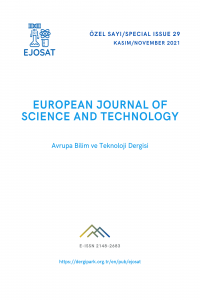Öz
In this paper, the relationship of the olive fly with the olive has been closely examined and the life cycle of the olive fly and olive are modeled in the Repast Simphony agent-based simulation environment to show how the population of olive flies changes and how the growing population affects olives. Using data, it has been observed how an olive fly reproduces in a short time and turns into many new generations. Increased olive fly population constitutes a serious threat to the success of control methods used for the damages of olives. In line with the data obtained from this study, olive fly population and damages to olives can be estimated for future years. Olive fly has been determined that the olive fly reduces the yield of the olive tree and it is necessary to combat the olive fly. It is very important to control the olive fly. Therefore, various control methods should be tried. An effective method for increasing the number of olive flies has been investigated. Olive fly numbers were obtained at the end of cultural biological and chemical struggles. In this study, the biological developmental stages of olive fly and olive can be observed. In line with the data obtained from this study, future years and damage to olives can be estimated.
Anahtar Kelimeler
Kaynakça
- Bento, A., Torres, L., Lopes, J., Sismeiro, R., 2002. A Contribution to the Knowledge of Bactrocera oleae (Gmel)in Tras-Os-Montes Region (Noertheastern Portugal): Phenology, Losses and Control. http://www.actahort.org/books/474/474_111.htm
- Economopoulos, A. P., Haniotakis, G. E., Michelakis, S., 1982. Population studies on the olive fruit fly, Dacus oleae (Gmel.) (Dipt.; Tephritidae) in Western Crete. J. Appl. Entomol., 463-476pp.
- Macal C. ,North M,2009.Tutarorial On Agent-based Modelling and Simulation
- Pala, Y., Nogay, A., Damgacı, E., Altın, M., 2001. Zeytin Bahçelerinde Entegre Mücadele Teknik Talimatı. Tarım ve Köyişleri bakanlığı, Tarımsal Araştırmalar Genel Müdürlüğü, Bitki Sağlığı Araştırmaları Daire Başkanlığı, Ankara, 84 s.
- Rice, R.E, Phillips, PA, Stewart-Leslie, J., Sibbert, G.S., 2003. Olive fly populations measured in central and southern California. 122-127pp
- Turanlı ,T, 2017. Gıda Tarım Haycancılık Bakanlığının kitabı Zeytin Entegre Mucadele Teknik Talimatı 18-22.
Türkiye'de Zeytin Sineğine (Bactrocera Oleae) Karşı Verilen Mücadelenin Etmen Tabanlı Modellenmesi ve Benzetimi
Öz
Bu çalışmada, zeytin sineğinin mücadelesi etmen tabanlı modelleme ile gösterilmiştir. Zeytin sineğinin zeytin ile olan ilişkisi yakından incelenmiştir. Zeytin sineğinin ve zeytinin biyolojik gelişim evreleri gözlemlenebilmektedir. Gerçek veriler kullanılarak, kimyasal ve biyolojik mücadelede zeytin sineği populasyonu değişim miktarı ve elde edilen zeytin verimi grafiksel olarak analiz edilebilmektedir. Bir zeytin sineğinin nasıl kısa bir zamanda üreyip çok sayıda yeni jenerasyona dönüştüğü görülmüştür. Artan zeytin sineği popülasyonu, zeytin zararları için kullanılan kontrol yöntemlerinin başarısı için ciddi bir tehdit oluşturmaktadır. Bu çalışmadan elde edilen veriler doğrultusunda gelecek yıllar için zeytin sineği popülasyonu ve zeytine vereceği zararlar tahmin edilebilir. Zeytin sineğinin zeytin ağacının verimini azalttığı ve zeytin sineği ile mücadele edilmesi gerektiği tespit edilmiştir. Zeytin sineğinin kontrolü çok önemlidir. Bu nedenle çeşitli kontrol yöntemleri denenmelidir. Zeytin sineği sayısını artırmak için etkili bir yöntem araştırılmıştır. Kültürel biyolojik ve kimyasal mücadeleler sonucunda zeytin sineği sayıları elde edilmiştir. Bu çalışmada zeytin sineği ve zeytinin biyolojik gelişim aşamaları gözlemlenebilmektedir. Bu çalışmadan elde edilen veriler doğrultusunda gelecek yıllar ve zeytinin zararları tahmin edilebilir.
Anahtar Kelimeler
Etmen etmen tabanlı modelleme zeytin zeytin sineği (bactrocera oleae)
Kaynakça
- Bento, A., Torres, L., Lopes, J., Sismeiro, R., 2002. A Contribution to the Knowledge of Bactrocera oleae (Gmel)in Tras-Os-Montes Region (Noertheastern Portugal): Phenology, Losses and Control. http://www.actahort.org/books/474/474_111.htm
- Economopoulos, A. P., Haniotakis, G. E., Michelakis, S., 1982. Population studies on the olive fruit fly, Dacus oleae (Gmel.) (Dipt.; Tephritidae) in Western Crete. J. Appl. Entomol., 463-476pp.
- Macal C. ,North M,2009.Tutarorial On Agent-based Modelling and Simulation
- Pala, Y., Nogay, A., Damgacı, E., Altın, M., 2001. Zeytin Bahçelerinde Entegre Mücadele Teknik Talimatı. Tarım ve Köyişleri bakanlığı, Tarımsal Araştırmalar Genel Müdürlüğü, Bitki Sağlığı Araştırmaları Daire Başkanlığı, Ankara, 84 s.
- Rice, R.E, Phillips, PA, Stewart-Leslie, J., Sibbert, G.S., 2003. Olive fly populations measured in central and southern California. 122-127pp
- Turanlı ,T, 2017. Gıda Tarım Haycancılık Bakanlığının kitabı Zeytin Entegre Mucadele Teknik Talimatı 18-22.
Ayrıntılar
| Birincil Dil | İngilizce |
|---|---|
| Konular | Mühendislik |
| Bölüm | Makaleler |
| Yazarlar | |
| Erken Görünüm Tarihi | 15 Aralık 2021 |
| Yayımlanma Tarihi | 1 Aralık 2021 |
| Yayımlandığı Sayı | Yıl 2021 Sayı: 29 |

